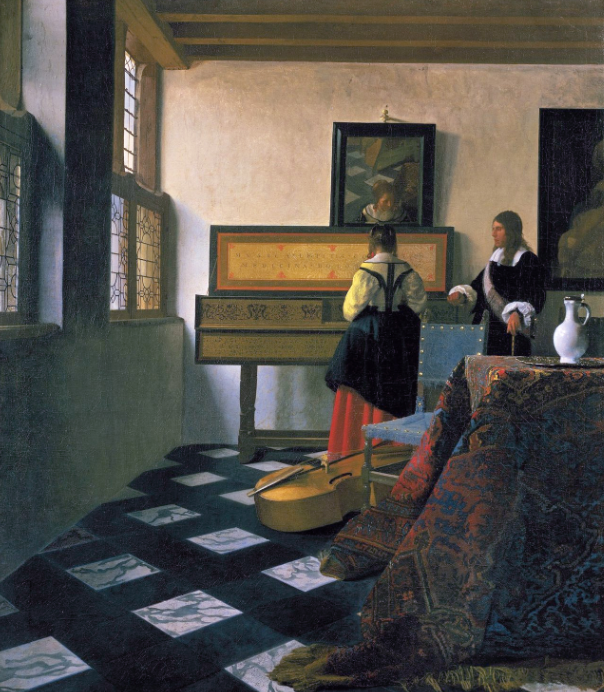Back in January it was announced that a film to which Colin Blakemore, Professor of Neuroscience and Philosophy in the School of Advanced Study, had contributed was nominated for a BAFTA as well as being shortlisted for an Oscar nomination. We caught up with him earlier this week to chat about, science, art and how exactly our very own eyes can conceal the truth.
Firstly I have to ask how a film covering both science and a Dutch renaissance master came to fruition. The subject areas seem rather removed from one another: how does this documentary marry the two?
It is indeed an unlikely story – about a successful Texan software engineer, Tim Jenison, with no training at all in painting, trying to simulate the techniques of Johannes Vermeer, arguably the greatest painter of the Dutch Renaissance. The movie show Tim’s extraordinary dedication to the heretical idea that some of the most admired artists of the Renaissance might have got a helping hand from optical devices (the camera obscura, curved mirrors and lenses). Of course, this isn’t Tim’s own hypothesis. It was promoted 15 years ago by the physicist Charles Falco and the artist David Hockney, most prominently in Hockney’s book Secret Knowledge. Indeed, Philip Steadman, a Professor in the Bartlett School of Architecture at UCL, in his 2001 book Vermeer’s Camera, argued, from a detailed comparison between the size and shape of Vermeer’s studio, the dimensions of Vermeer’s canvases and the geometry of his compositions, that he might have painted from an image projected inside a camera obscura constructed in that room. But Tim Jenison wanted to go beyond armchair speculation and to test the theories with the most direct experiment imaginable – trying to paint like Vermeer.
In his Guardian interview Mark Kermode described Tim’s Vermeer as “a mesmerising film that offers both an intriguing insight into genius and a convincing analysis of the unity of art and science”. How did you find yourself embarking on such a unique project? Why was it of such interest to you?
I must say that my involvement in the film wasn’t enormous, and it came relatively late in the production of the film, which covers a decade of Tim Jenison’s obsession with Vermeer. The production team contacted me in 2010, on the suggestion of Professor Margaret Livingstone, a vision scientist at Harvard. They wanted to know about the way in which we perceive the world on the basis of rather limited, pre-processed information reaching the brain from the eyes. In particular, they were intrigued by the problem that artists face as they try to represent gradients of brightness and colour in paintings – something that Vermeer did remarkably well. This question touched a nerve for me, because it is just one example of a general paradox that I’ve thought about for many years – a problem that I discussed endlessly with Ernst Gombrich and Richard Gregory. What we perceive is not simply a faithful reproduction of the physical characteristics of the image in the eye. So, how do representational artists avoid the circularity of painting what they “see” rather than the subject of their seeing?
Think of that visual illusion in which the apparent brightness of two physically identical grey patches is dramatically changed by the intensity of the background. A grey patch on a black background looks brighter than exactly the same patch on a white background. If an artist wanted to paint a picture of these patches in a way that reproduced precisely the same perceptual experience, he or she would have to paint the two grey patches with exactly the same pigment, even though they look different to him or her. If a picture is to reproduce in the viewer’s mind the perceptual experience of the artist, it must re-create in the viewer’s eye an image similar to the image that was in the artist’s eye.
As the film progresses we see that simple optical techniques could have helped artists to paint a ‘truer’ picture of the subject of the painting. How have we come to understand that we don’t see the whole ‘truth’?
The point is that our eyes and brains employ clever tricks in order to transmit, process and interpret the huge amount of information in the retinal image. The task of vision is to understand the outside world, not to reproduce the retinal image. Some of those tricks make the ultimate percept more appropriate for helping us to understand the true nature of the objects around us. A good example is what psychologists call ‘size constancy’. Hold your hands up in front of you, one twice as far away as the other, and ask yourself how large they appear to be. Does the more distant look literally half the size of the near one? Absolutely not: they seem to be about the same size, just as your two hands really are. But the retinal image of the distant hand is indeed half the size of that of the closer hand! The brain generates a visual experience more like the reality of the objects than like the nature of the images in your eye. Presumably this accounts for the fact that artists often tend to make the distant objects in their pictures too large. One feature of Vermeer’s paintings that alerted Steadman to the possibility that he was using optical aids is the accurate representation of the relative size of figures in his paintings.
Why do you think the seemingly strange and highly specialised story of ‘Tim’s Vermeer’ has connected with audiences on such a human level?
It is surprising that such an apparently quirky, almost academic story could make a popular movie (and be nominated for a BAFTA). Well, since I was only very peripherally involved in the film, I hope that I’m not being immodest by saying that it works at many different levels. Of course, the film is interesting to nerds like me, because it describes the personal obsession of an amateur scientist. But it’s fascinating because he was interested in questions that most people would think are beyond the scope of science, and he then tackled them with practical experiments. But the movie also has a human element that goes beyond the actual experiments. In some ways Tim Jenison is like Miss Marples or Hercule Poirot – a loveable but brilliant amateur detective.
Tim faces all kinds of difficulties and set-backs along the way, but in the end – with no education in art – he paints his own ‘Vermeer’ and it’s greeted with amazement when he shows it to David Hockney and Philip Steadman at the end of the film.
Of course, the fact that anyone can use optical tricks to make an impressive copy of a great work of art doesn’t prove that Vermeer and others used the same techniques. And it doesn’t account for Vermeer’s brilliant composition and the serenity of his depictions of everyday life. But it does raise deep questions about the role of practical methods in artistic creativity.
Professor Colin Blakemore will be introducing a screening of the film at Ilkley Film Festival on Sunday 16 February and the winners of this year’s BAFTA Awards will be announced the same evening. This year the ceremony is to be hosted by Stephen Fry at the Royal Opera House and broadcast live on BBC1.
Related Articles.
Professor Blakemore reflecting on art and science, Start the Week, BBC Radio 4 (From 23.37)


